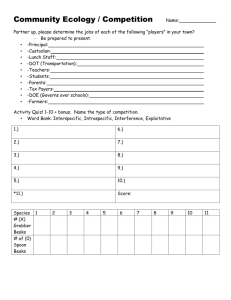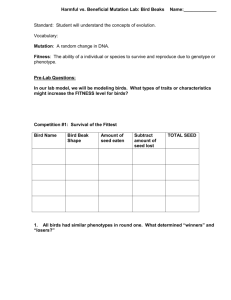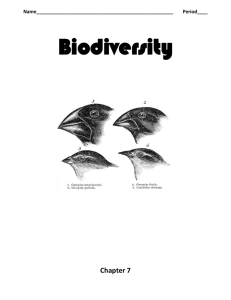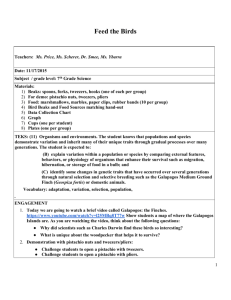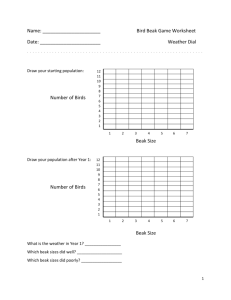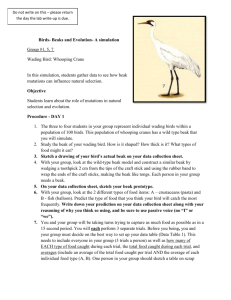THE MOLECULAR CONNECTION
advertisement
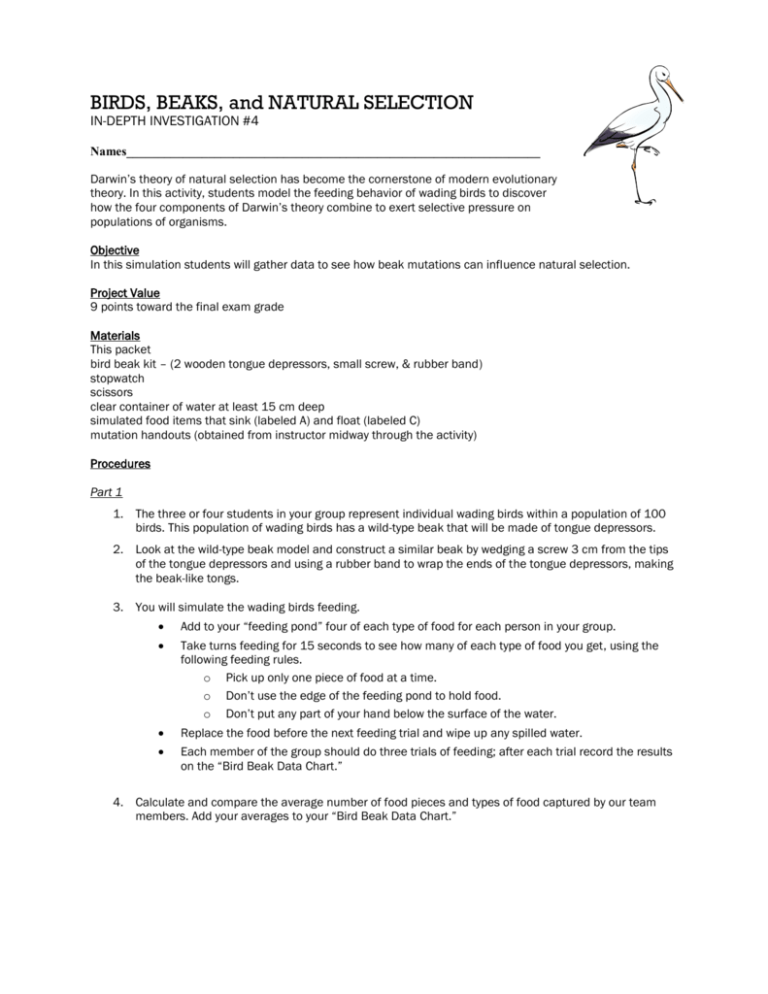
BIRDS, BEAKS, and NATURAL SELECTION IN-DEPTH INVESTIGATION #4 Names__________________________________________________________________ Darwin’s theory of natural selection has become the cornerstone of modern evolutionary theory. In this activity, students model the feeding behavior of wading birds to discover how the four components of Darwin’s theory combine to exert selective pressure on populations of organisms. Objective In this simulation students will gather data to see how beak mutations can influence natural selection. Project Value 9 points toward the final exam grade Materials This packet bird beak kit – (2 wooden tongue depressors, small screw, & rubber band) stopwatch scissors clear container of water at least 15 cm deep simulated food items that sink (labeled A) and float (labeled C) mutation handouts (obtained from instructor midway through the activity) Procedures Part 1 1. The three or four students in your group represent individual wading birds within a population of 100 birds. This population of wading birds has a wild-type beak that will be made of tongue depressors. 2. Look at the wild-type beak model and construct a similar beak by wedging a screw 3 cm from the tips of the tongue depressors and using a rubber band to wrap the ends of the tongue depressors, making the beak-like tongs. 3. You will simulate the wading birds feeding. Add to your “feeding pond” four of each type of food for each person in your group. Take turns feeding for 15 seconds to see how many of each type of food you get, using the following feeding rules. o Pick up only one piece of food at a time. o Don’t use the edge of the feeding pond to hold food. o Don’t put any part of your hand below the surface of the water. Replace the food before the next feeding trial and wipe up any spilled water. Each member of the group should do three trials of feeding; after each trial record the results on the “Bird Beak Data Chart.” 4. Calculate and compare the average number of food pieces and types of food captured by our team members. Add your averages to your “Bird Beak Data Chart.” Part 2 5. Assume that the wading birds in your population (your group) will undergo mutations in the genes that code for beak length. Each student will pick a mutation handout from the instructor that will explain the kind of mutation and how it will affect the beak size of your offspring. 6. Follow the instructions on your mutation sheet. If you received a beak mutation that requires a change, you will need to create the new beak for your offspring. For long beak mutations, use the extra-long glued tongue depressors, a screw, and the rubber band to make the beak tong-like. For short beak mutations, cut the wild-type beaks exactly in half using the scissors. Some mutations do not affect your offspring’s beak; you will use the same wild-type beak. 7. You will now feed as your offspring, Generation 1. Because this time all members of a group will feed at once, two groups will work together during the feeding of the offspring. While one group feeds, the other group will time and monitor the feeding. Then teams will switch roles. There will be three feeding trials of 15 seconds each, following the feeding rules, and food will be replaced between trials. Record your feeding data on the “Bird Beak Data Sheet” after each trial. 8. Determine the survival rate of your offspring by consulting the “Wading Bird Survivability Table” below and record the results in the “Bird Beak Data Chart” in the Generation Results column. For example, according to the “Wading Bird Survivability Table” if the parent bird averaged 7 pieces of food, then its offspring must “consume” at least two (2) pieces of food to survive and reproduce one offspring, but 5 or more pieces of food to survive and reproduce 4 offspring. Birds that obtain less than two (2) pieces of food 9. Compare your data and discuss the following questions in your group. Record the responses on a separate sheet of paper to be handed in with this laboratory. a. Why did some mutations lead to a change in beak length and some not? b. What happened when the offspring with changed beaks and the offspring with wild-type beaks fed together? c. For each type of beak, which type of food is consumed most? Is this what you expected or is it surprising? Why? d. Based on the number of food items consumed, which birds survived? Which birds survived and produced the most offspring? e. Why might some surviving birds produce different numbers of offspring? f. What other factors besides beak length affected feeding in your population? g. What would you expect to happen to the population if the next generation of wading birds were allowed to feed and reproduce under the same conditions? h. How did this simulation demonstrate natural selection? i. What is the role of mutations in natural selection? j. What is the role of sexual reproduction in natural selection? k. Which does natural selection act upon: the genotype or phenotype of traits? l. Explain the significance of the following statement: Natural selection operates on individuals, but evolution occurs at the level of the population. m. How is the simulation like the real world and how is it different in relation to feeding, mutations, beak lengths, and reproduction? 10. When you have finished the activity, clean up any spilled water, dismantle the “beak” that you have made, and take all food items out of the feeding ponds. Assessment Rubric Excellent Discussion Needs Improvement Work well together to create beaks and conduct their simulation ● Work well to analyze their data. Work together to create beaks and conduct their simulation ● Have some problems analyzing their data Do not work together to create their beaks and /or conduct their simulation ● Don’t understand how to analyze their data. Data is well organized ● Their conclusions accurately reflect their data Data is fairly well organized ● Their conclusions don’t quite reflect all of their data. Data is not well organized● They do not know how to use the data to reach a conclusion. Thoroughly understand how their simulation relates to natural selection and how its similar and different than the real world ● Partially understand how their simulation relates to natural selection and how its similar and different than the real world ● Don’t understand how their simulation relates to natural selection and how its similar and different than the real world ● Team Process Team Product Satisfactory

